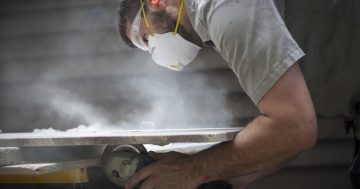
Hail blankets the lawns of Parliament House in January 2020. Photo: David Foote, AUSPIC/Department of Parliamentary Services.
The hailstorm that left a trail of devastation in its wake as it tore through Canberra in January 2020 might have been over in just 15 minutes, but many major commercial property insurance claims have yet to be dealt with.
According to Allinsure managing director Peter Chamberlain, there are still clients out there who are unaware their building’s roof was damaged in the event.
Most recently, more than $1 million worth of damage to a roof was discovered at a commercial building in Fyshwick.
“Because the roof wasn’t leaking, nobody had gone up there to check anything and it wasn’t until Allinsure was appointed to look after the client that this was picked up,” says Peter.
He urges people who haven’t completed a thorough inspection of their properties to do so immediately.
“One big learning from the hailstorm already is that the industry needs to move more quickly to identify who has suffered a loss,” says Peter.
“For clients, it can have a big impact if your metal roof has been dented as water and dust pools in the dents and can lead to rust and corrosion significantly shortening the lifespan of the roof.”
Damage caused by rust or corrosion is considered to be general wear and tear, and therefore not covered by residential and business insurance policies which are designed to cover unforeseen events.
“In five years from now, if you have a problem you’re going to have a harder time proving to your insurance company that it was originally caused by the hailstorm,” says Peter.
He also adds that most metal roofs will have their warranty voided if they are dented.
The January 2020 hailstorm was just one of a long string of catastrophes to hit Australia in a short period of time, including the Black Summer bushfires and flooding in Queensland and NSW.
Peter says it took the system being put under immense stress to discover some of the cracks that were previously unnoticed.
“Generally, the insurance industry in one area does not carry enough capabilities to service a catastrophe,” he says.
“So when events such as the hailstorm happen, all of the specialists from around the country and sometimes overseas are sent to the place where the event occurred to help in the immediate aftermath, which typically works extremely well.”
With so many catastrophes in such a short period of time, the system was pushed almost to breaking point which led to normal processes not always being followed.
One of the knock-on effects of this is that 18 months on from the hailstorm, insurers still have another six months or more of repairs to do.
According to Peter, two key learnings have emerged in the wake of the catastrophe.
The first is the need for independent assessors and specialist building consultants to determine the scope of works on a claim rather than allowing individual building companies to determine these alone.
“When multiple quotes are required by insurers for comparison, having each builder write their own scope of works first makes little to no sense,” he says.
“In some cases, the two or three builders’ scopes for the same job were so different it made comparing the quotes all but impossible.”
Such variation also often resulted in the final price of the claim being much higher than had been quoted. This largely occurred when the initial scope of works from the selected panel builder lacked significant items or contained provisional sums which were far too low in an attempt to win the job, or simply occurred due to pure oversight.
The other issue that Peter saw post-hailstorm was a reliance on interstate builders flying in and flying out – using interstate contractors – and then likely leaving immediately after the works were completed.
This is problematic for a few reasons.
“Using interstate builders instead of our reputable and trusted local builders highlighted the importance of having teams of quality and professional trades on-hand to fulfil the required work,” says Peter.
“This led to the interstate builders bringing in contractors from other states and territories throughout the challenges posed by the COVID-19 pandemic who were unused to working under local regulations and conditions.”
For Peter, this kind of practice begs the question of if, in 18 months time, the works completed have an issue such as a water leak, who is going to be there to fix it?
To combat this, his answer is simple: “Support local.”

















